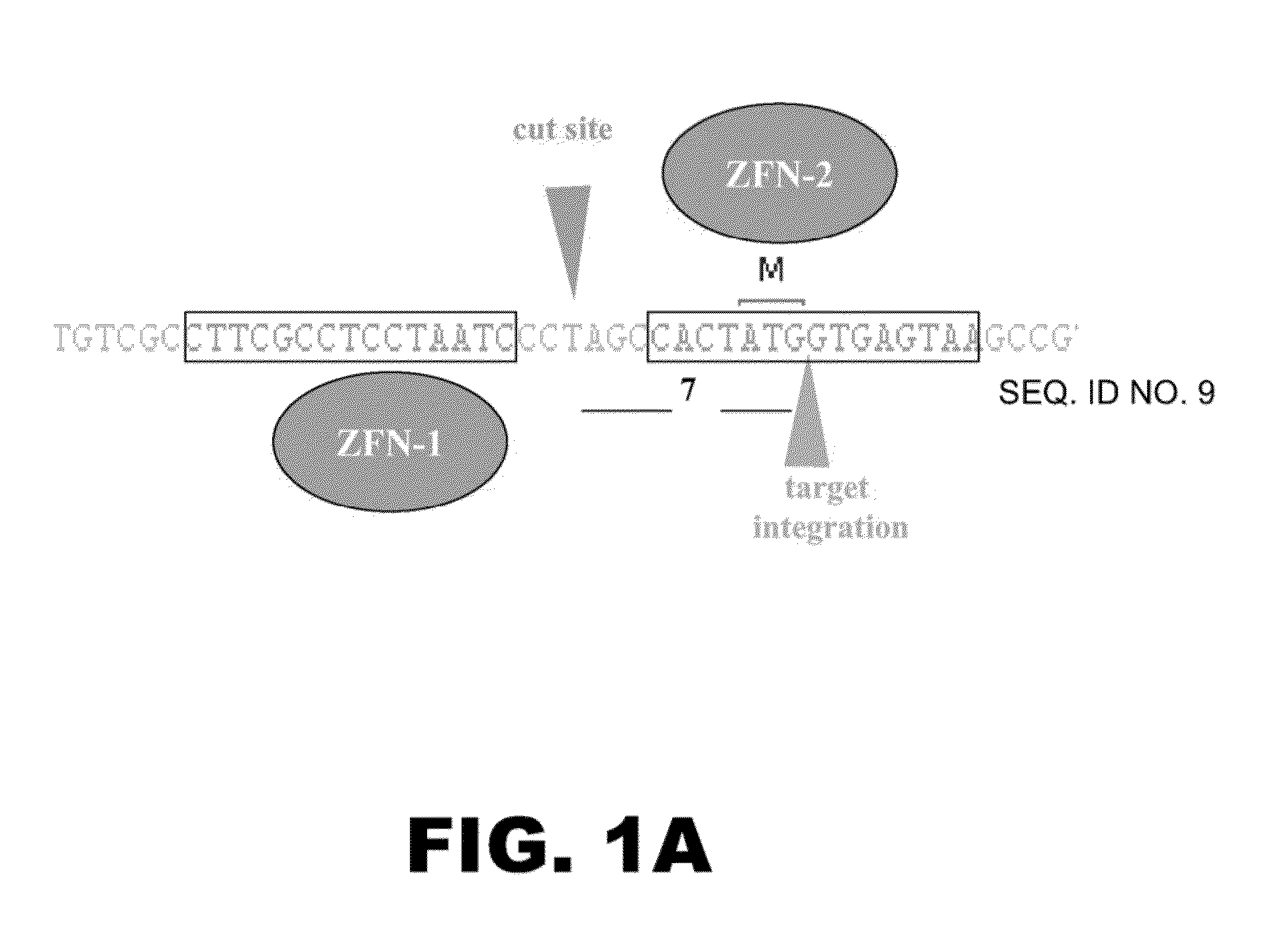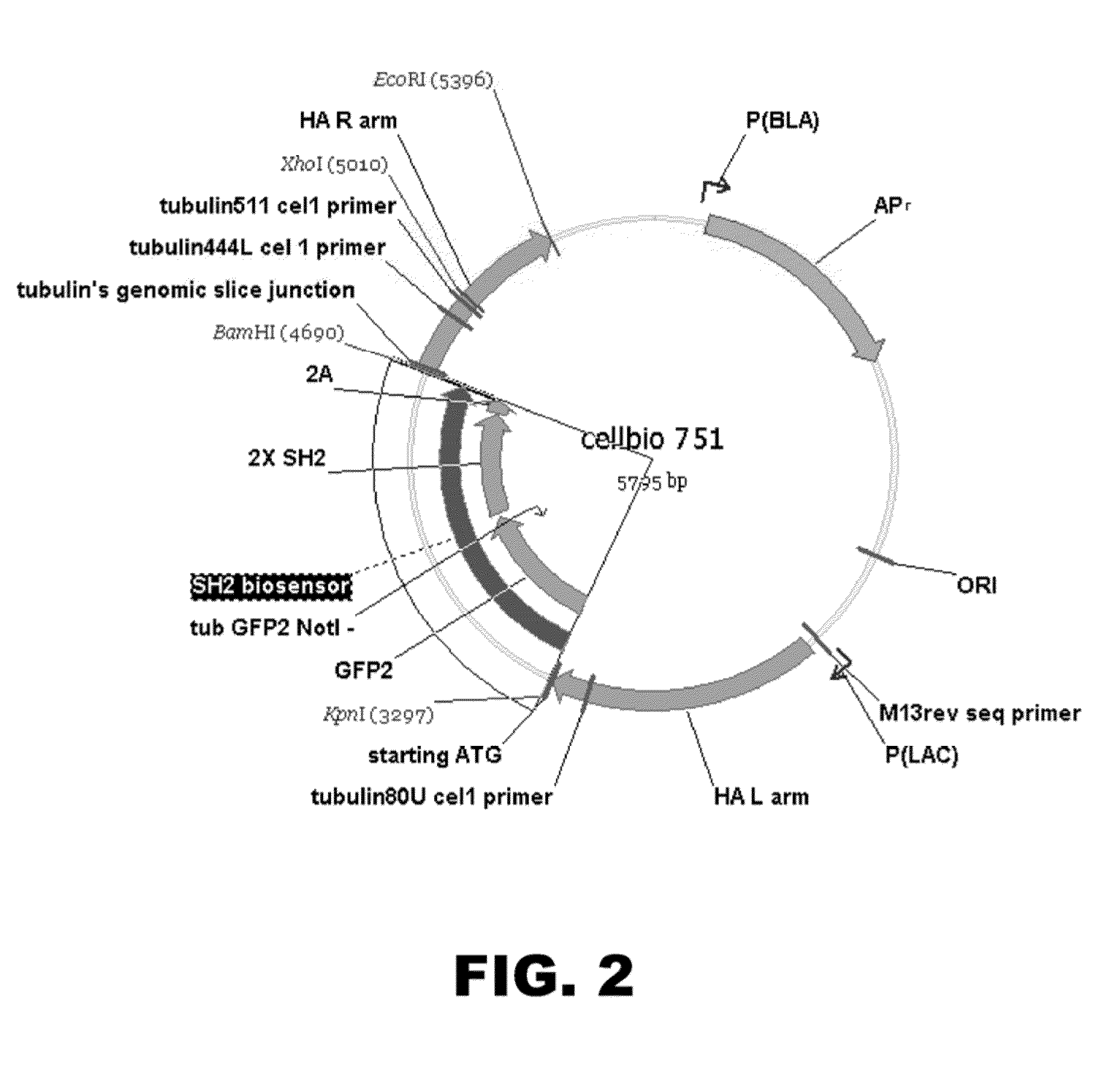Use of endogenous promoters to express heterologous proteins
a technology of endogenous promoters and heterologous proteins, which is applied in the direction of viruses/bacteriophages, instruments, peptides, etc., can solve the problems of not only a time-consuming process, but also a risk of silencing
- Summary
- Abstract
- Description
- Claims
- Application Information
AI Technical Summary
Benefits of technology
Problems solved by technology
Method used
Image
Examples
example 1
Using the TUBA1 B Promoter to Express a Heterologous Protein
[0092]The following example details use of a tubulin promoter to regulate the expression of heterologous proteins. TUBAIB, which codes for tubulin alpha-1B, was chosen as the target chromosomal sequence. A pair of zinc finger nucleases (ZFNs) was designed to target a location in the human TUBA1B locus. For more details regarding ZFNs and methods of using to edit chromosomal regions see PCT / US2010 / 43167, the disclosure of which is incorporated by reference herein in its entirely. One ZFN was designed to bind the sequence 5′ CTTCGCCTCCTAATC 3′ (SEQ ID NO:1), and the other ZFN was designed to bind the sequence 5′ CACTATGGTGAGTAA 3′ (SEQ ID NO:2) (FIG. 1A). Upon binding, the ZFN pair introduces a double-stranded break in the sequence 5′ CCTAGC 3′ that lies between the two ZFN recognition sequences. Capped, polyadenylated mRNAs encoding the ZFN pair were produced using known molecular biology techniques.
[0093]The gene of interes...
example 2
Using the ACTB Promoter to Express a Heterologous Protein
[0096]The following example was designed to test the use of a stronger promoter. A well known strong promoter is within the ACTB locus, which encodes β-actin. A pair of ZFNs was designed to target the human ACTB locus (FIG. 5). One ZFN was designed to bind the sequence 5′ GTCGTCGACAACGGCTCC 3′ (SEQ ID NO:3), and the other ZFN was designed to bind the sequence 5′ TGCAAGGCCGGCTTCGCGG 3′ (SEQ ID NO:4). Upon binding, the ZFN pair introduced a double-stranded break in the sequence 5′ GGCATG 3′ that lies between the two ZFN recognition sequences.
[0097]A donor plasmid was designed to provide the SH2 biosensor sequence, as well as tag the endogenously produced β-actin (i.e., GFP-2×-SH2(Grb2)-2A-RFP) (FIG. 6). The nucleic acids were introduced into cells, and two fluorescent proteins were made (i.e., GFP-SH2 biosensor and RFP-actin). The fluorescence of each protein was monitored using fluorescent microscopy.
[0098]A549 cells were trans...
example 3
Using the LMNB1 Promoter to Express a Heterologous Protein
[0099]To target the LMNB1 locus, which codes for lamin B1 protein, another pair of ZFNs was made (FIG. 8). One ZFN was designed to bind the sequence 5′ CCTCGCCGCCCCGCT 3′ (SEQ ID NO:5), and the other ZFN was designed to bind the sequence 5′ GCCGCCCGCCATGGCG 3′ (SEQ ID NO:6). Upon binding, the ZFN pair introduces a double-stranded break in the sequence 5′ GTCTCC 3′ that lies between the two recognition sequences.
[0100]A donor plasmid may be constructed to comprise a sequence encoding a heterologous protein that is flanked by LMNB1 sequences upstream and downstream of the ZFN cleavage site. The nucleic acids encoding the ZFNs and the donor plasmid may be introduced into cells, and the cells may be monitored as detailed above.
PUM
| Property | Measurement | Unit |
|---|---|---|
| color | aaaaa | aaaaa |
| color photographs | aaaaa | aaaaa |
| fluorescence microscopy | aaaaa | aaaaa |
Abstract
Description
Claims
Application Information
 Login to View More
Login to View More - R&D
- Intellectual Property
- Life Sciences
- Materials
- Tech Scout
- Unparalleled Data Quality
- Higher Quality Content
- 60% Fewer Hallucinations
Browse by: Latest US Patents, China's latest patents, Technical Efficacy Thesaurus, Application Domain, Technology Topic, Popular Technical Reports.
© 2025 PatSnap. All rights reserved.Legal|Privacy policy|Modern Slavery Act Transparency Statement|Sitemap|About US| Contact US: help@patsnap.com



